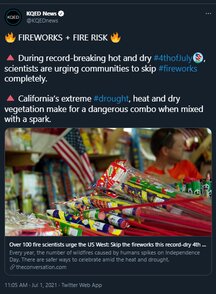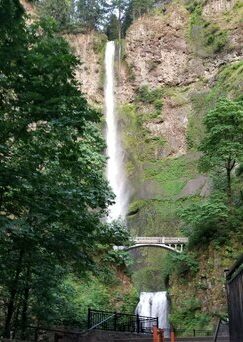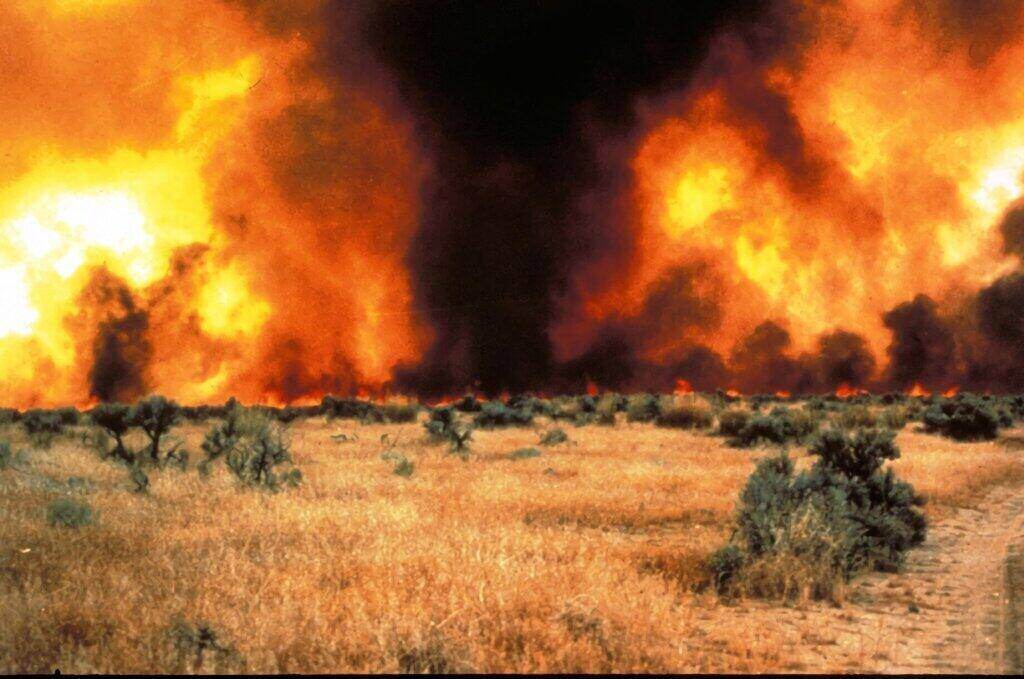|
Getting your Trinity Audio player ready...
|

The 2021 fire season is well underway in the United States, prompting officials to warn people against using personal fireworks during the Fourth of July celebrations. As of July 1, 45 large fires that have consumed 672,653 acres continue to burn, according to the National Interagency Fire Center (NIFC).
Fire bans are announced in regions experiencing drought since the lack of rain dries the vegetation and raises concerns for a busy fire season. Much of the nation is experiencing some levels of dryness; however, more than half of the country is abnormally dry.
The combination of fireworks and drought is an especially hazardous situation.
 Reports from the week of June 23-29 indicate that 47.2 percent of the lower 48 states are in the midst of drought conditions, reflecting changes for the worst for the fourth straight week.
Reports from the week of June 23-29 indicate that 47.2 percent of the lower 48 states are in the midst of drought conditions, reflecting changes for the worst for the fourth straight week.
Over 52 percent of the west is currently experiencing grave drought conditions — Arizona, California, Colorado, Idaho, Montana, New Mexico, Nevada, Oregon, Utah, Washington, and Wyoming,
Drought conditions have also worsened in the New England region. Even Alaska and Hawaii are experiencing drought conditions.
Drought means there is plenty of fuel for fires and reduced water to combat them. In the past 10 years, lightning strikes sparked an average of 8,000 fires a year, whereas humans started an average of 64,100. The NIFC writes:
Some people walk away without putting out their campfire, others light fireworks around dry brush and grass. These behaviors are dangerous and unlawful.
Fires Started By Humans Lighting Fireworks
Last year, nearly 9 million acres were scorched in 52,113 wildfires. Most wildfires are human-caused. In fact, 88 percent of all wildfires between 2016 and 2020 were started by humans.
 A memorable fire was started by a 15-year-old boy in the Columbia River Gorge in 2017. The Eagle Creek Fire started on September 2; 89 days later, it was 100 percent contained.
A memorable fire was started by a 15-year-old boy in the Columbia River Gorge in 2017. The Eagle Creek Fire started on September 2; 89 days later, it was 100 percent contained.
The fire was fueled by vegetation that had not experienced rain in nearly 3 months. As a result, the blaze jumped the river devastating over 48,000 acres of healthy forests in Oregon and Washington. Fortunately, only four buildings were destroyed, and no one lost their life.
Not All Fires Are Caused by Fireworks Become Massive Wildfires — Some Are Quite Small by Comparison
One such fire involved six-year-old Brian and a sparkler on the morning of July 4, in the late 80s. He was excited about the big fireworks display he and his mom would be attending that night. While she was in the kitchen, fixing breakfast. He snuck the box of fireworks they were going set off before watching the big display into his bedroom and lit one of the sparklers.
When his mom called him for breakfast, he stuffed the box and the still-lit sparkler under his bed. Brain says he really believed he put it out. But the sparks lit the other fireworks resulting in their 6-unit apartment building burning to the ground.
Now, in his 40s, he remains haunted by the impact his childlike actions made on everyone involved. To this day, he has not lit any other fireworks, saying:
I learned the damage fireworks can do. I’ll leave it for the professionals. Thanks.
Using the keyword fireworks on Twitter brings up numerous news sites issuing warnings and comments.
One tweet claimed fireworks would be legal in California if Gov. Gavin Newsome had hired people to rake the forest floor, while another blamed the governor for not building enough reservoirs in the state to hold all of the rainwater.
@NYPD Precinct 77 posted a video showing fireworks blowing up and added, “besides being illegal, #fireworks can be extremely dangerous.” @Dragofix wrote:
Over 100 fire scientists urge the US West: Skip the #fireworks this record-dry 4th of July.
Written by Cathy Milne-Ware
Sources:
NOAA|National Integrated Drought Information System: Advancing Drought Science and Preparedness Across the Nation
CNN: Millions in the West are still under heat warnings as parched conditions threaten even more wildfires; by Aya Elamroussi
Center for Disaster Philanthropy: 2020 North American Wildfire Season
National Interagency Fire Center: Fire Information
Friends of the Columbia Gorge: Eagle Creek Fire: Frequently Asked Questions
Featured and Top Image Courtesy of USFWS Headquarters’ Flickr Page – Creative Commons License
Second Inset Image Courtesy of Cathy Milne-Ware – Used With Permission



